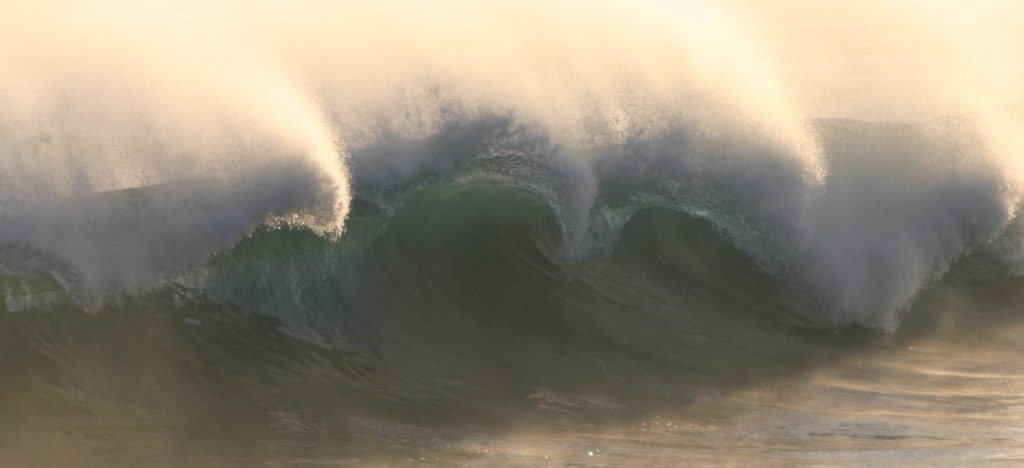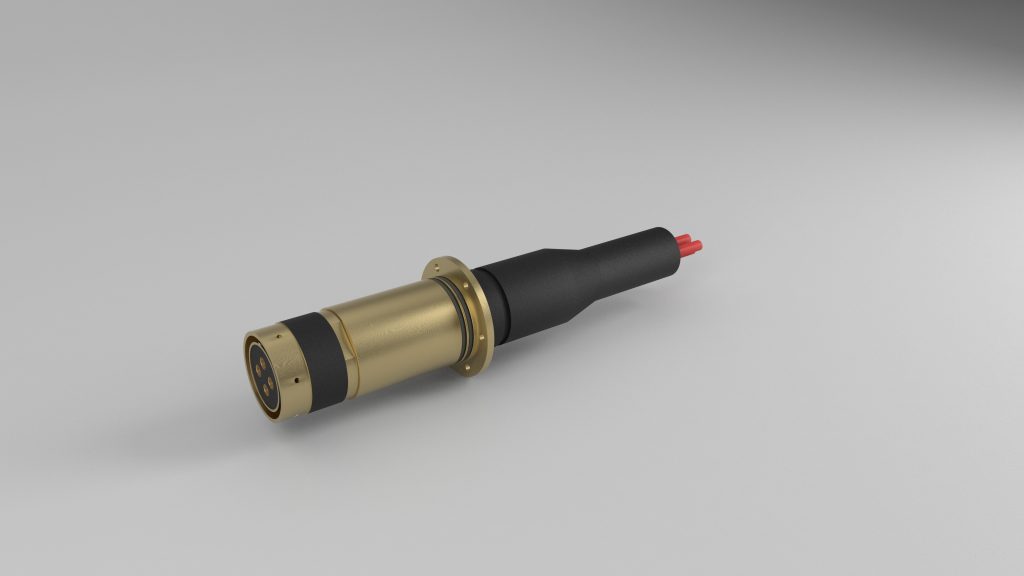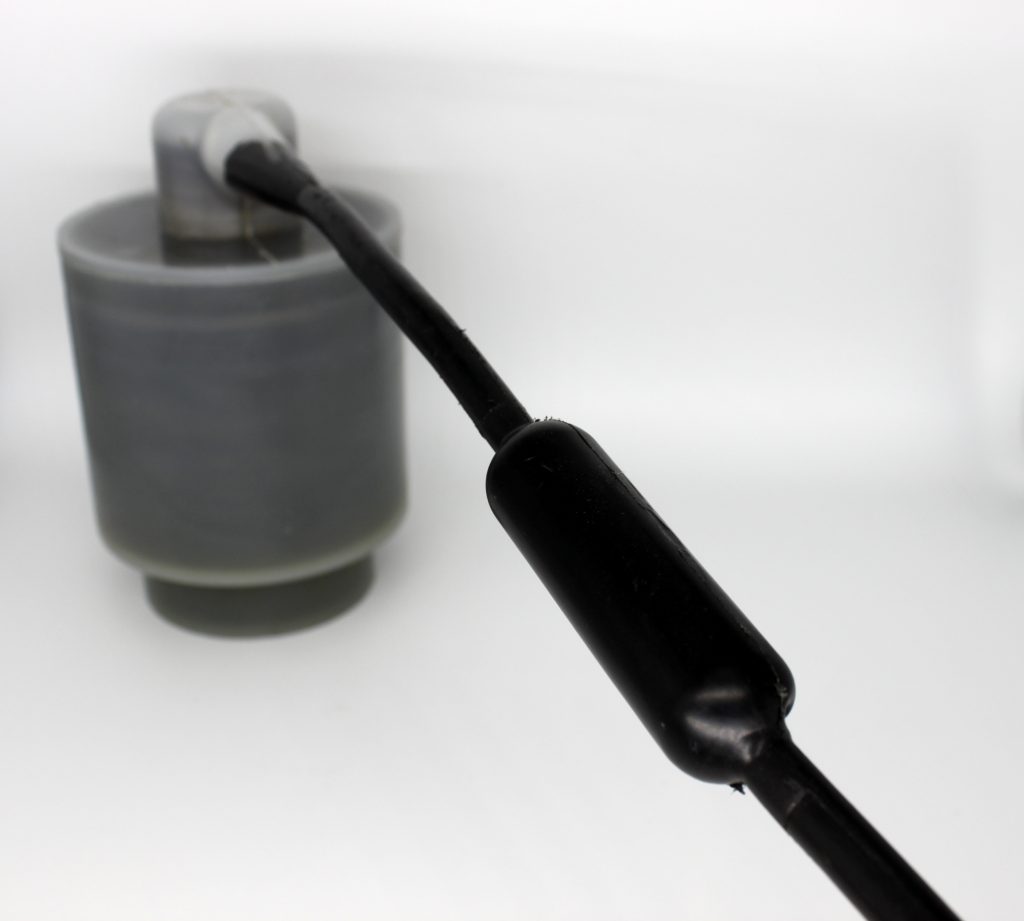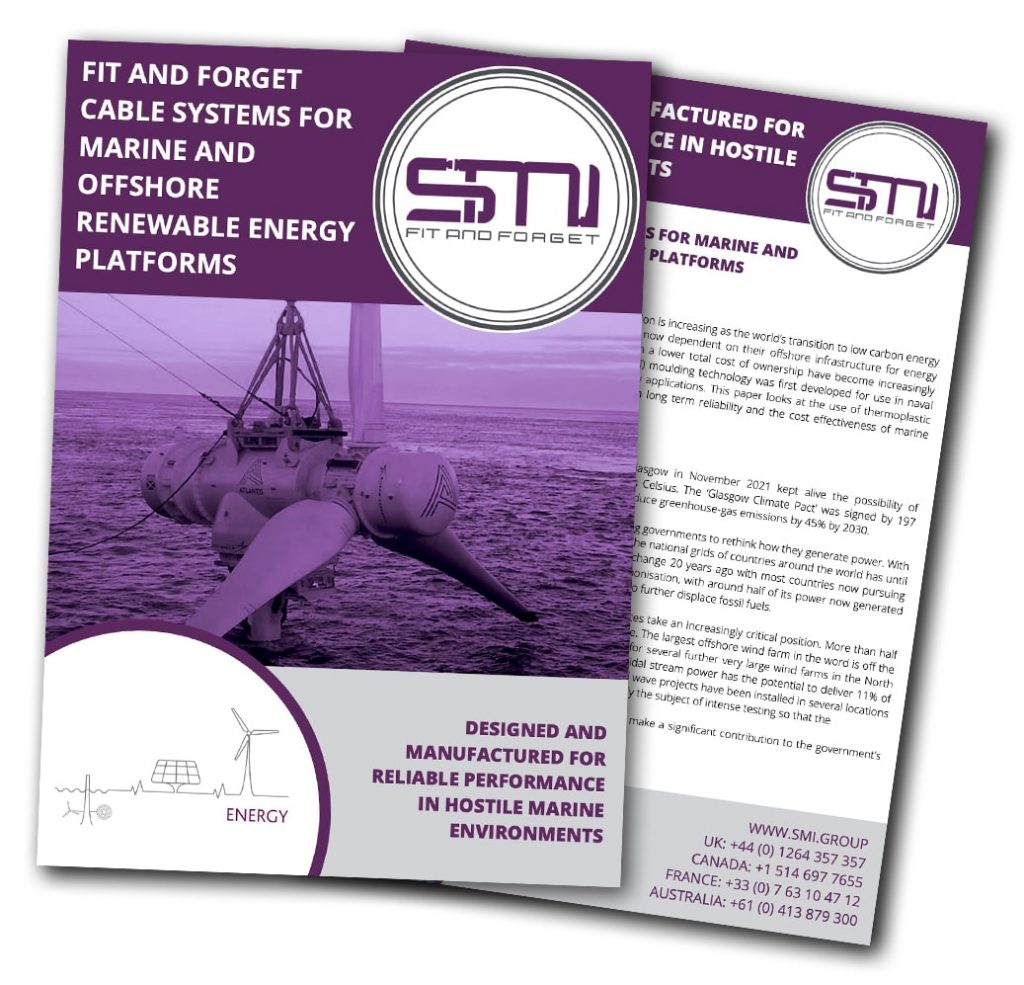Fit and forget cable systems for offshore and marine renewable energy platforms
The importance of marine renewable energy generation is increasing as the world’s transition to low carbon energy accelerates. With countries such as the UK already now dependent on their offshore infrastructure for energy security, ways to ensure long term performance with a lower total cost of ownership have become increasingly important. Scientific Management International’s (SMI) moulding technology was first developed for use in naval submarines and soon transferred into marine energy applications. This paper looks at the use of thermoplastic polyethylene moulded cable systems to support both long term reliability and the cost effectiveness of marine renewable energy investments.
Rethinking power generation
The COP26 climate change conference hosted in Glasgow in November 2021 kept alive the possibility of restraining global temperature increase to 1.5 degrees Celsius. The ‘Glasgow Climate Pact’ was signed by 197 attending parties and formally recognised the need to reduce greenhouse-gas emissions by 45% by 2030.
This and previous climate change commitments are driving governments to rethink how they generate power. With only a few exceptions, nearly all power supplied through the national grids of countries around the world has until recently been generated from fossil fuels. This began to change 20 years ago with most countries now pursuing alternatives. The UK is one of the global leaders in decarbonisation, with around half of its power now generated from zero carbon sources, with ambitious targets in place to further displace fossil fuels.
Within the UK’s renewables mix, marine and offshore sources take an increasingly critical position. More than half of the country’s wind sourced power is now located offshore. The largest offshore wind farm in the word is off the coast of Yorkshire, with planning permission being sought for several further very large wind farms in the North Sea. It’s not only offshore wind that the UK is investing in. Tidal stream power has the potential to deliver 11% of the UK’s current annual power needs [1]. Innovative tidal and wave projects have been installed in several locations around Britain’s coast. This infrastructure is currently the subject of intense testing so that the technology can be developed to make a significant contribution to the government’s drive for net-zero.
With countries such as the UK evidently committed to growing marine and offshore renewable energy generation, it’s axiomatic that they will be increasingly dependent on the reliability of their infrastructure for power supply. Platforms must be able to operate unaffected by the extremely hostile conditions associated with the marine environment. Given the relative inaccessibility of such platforms, maintenance and repair programmes are logistically complex and very expensive, so robust components are vital to avoid high costs over their lifetime.
Effects of the marine environment on renewable energy generation platforms

Electrical systems and electronics embedded on marine renewable energy generation platforms perform a number of critical functions, including power export, system control, and the creation and communication of monitoring data.
During their life, which might be measured in decades, marine platforms are exposed to a wide range of environmental challenges. These include extremes of pressure and temperature, turbidity created by tide and wave action, microbial growth, electrolysis, variable moisture levels or complete long-term immersion in sea water. Any of these factors could damage the integrity of cable systems, potentially opening leak paths to electrical connections and complex electronics. Once inundated, failures will inevitably occur, negatively effecting the performance of the platform.
All of these challenges need to be strongly mitigated against. Ideally, the measures selected must remain effective over a long time period to avoid high frequency maintenance, repair or replacement activity. Marine platforms are by their nature remote and many systems installed on them are relatively inaccessible, for example those below sea levels may require suitably qualified divers to work on them. The cost of marine logistics and expertise associated with maintaining the performance of marine platforms needs to be minimised to support the commercial viability of this critical infrastructure, leading many operators to favour wet mating connections which can be connected subsea without costly recoveries of cable or equipment.
Water ingress more likely to occur at cable connections
The fundamental quality required of cable systems installed on marine renewable energy generation platforms is that they are and will remain impermeable to water. It is possible for cable jackets to leak and we will discuss mitigating against problems associated with that issue shortly. However, the most likely, and damaging, point for a leak to occur is at a manufactured physical discontinuity in the cable. This could be where individual lengths of cables have been joined with a splice or a connecter, the latter sometimes being located at a point of penetration through the ‘hull’ of the platform.
Thermoplastic polyethylene moulding for lifelong impermeability
SMI’s principal competency is in thermoplastic polyethylene (PE) moulding. We apply this technology to encapsulating splices or connectors with a thermoplastic, amalgamating it at an atomic level with adjacent materials, including the cable jacket and the splice or connector structure, to ensure lifetime impermeability.
Polyurethane (PU) is a thermoplastic commonly used for cable jackets. It has significant elasticity and wear resistance properties. However, it absorbs water, a tendency that increases as temperature rises, which degrades its electrical insulation over time. This reduces its suitability as an encapsulation material.
PE has a unique combination of excellent dielectric characteristics and high electrical resistivity, as well as negligible moisture permeation and fluid absorption. It delivers orders of magnitude better insulation resistance than other materials. Crucially, PE does not absorb fluids or moisture over time as other materials do, which is what makes it the only material that can deliver 30+ years sealing performance.
While these qualities are highly desirable, PE expands and contracts volumetrically by more than 30% when heated to melting point and has a very low thermal conduction coefficient. This makes it notoriously difficult to process, and its low surface energy makes it very difficult to bond to any other materials. In general epoxies, polymeric and rubber materials do not bond well, or at all, to PE.
SMI has overcome those obstacles, having developed the knowledge and processes required to manufacture exceptional bonding of PE to metals and rigid polymers. We use PE in our PlastEthUrm™ range, a dual sealing moulding so robust that cable mouldings are offered with a standard guarantee of ten years, reflecting the confidence that comes from more than 10,000 installations with zero leaks.
Our engineers will work with you to find the right solution for your projects, typically including:
- Underwater dry or wet mate electrical connectors
- Submarine cables and hybrid harnesses
- Water blocked electrical and fibre optic penetrators
- Three phase HV and MV assemblies
- Umbilical cables with power, signal and fibre optic bundles
- Subsea junction/splice boxes

Adhesion science for marine cable systems
For cable harnesses and connectors to provide reliable performance throughout a platform’s life, the integrity of their moulded terminations must be maintained. In addition to mechanical adhesion, which relies on roughening the adherent surfaces to increase contact area and interlocking, chemical bonding provides a very high strength union at the molecular level, guaranteeing the best long-term resistance to penetration.
Chemical bonding occurs when the atoms of adjacent materials containing free electrons and electron holes interact to achieve a lower state of equilibrium. By definition, the bond will be stronger than the weaker of the two materials and orders of magnitude greater than any mechanical joint. High pressure and high temperature provided during SMI’s thermoplastic moulding process provides the energy required for this bonding to occur.
Moulding is initiated by heating injected PE granules and the thermoplastic cable jacket to their melting point. The liquefied plastics flow and mix together so that they cool into a completely homologous material. The cable jacket shape is tailored to incorporate the profile required for the termination without the need for any join or interface. This amalgamation process is absolutely key to long-term sealing, as with no interface present, fluid can never enter a thermoplastic moulding. It also enables complex shapes to be moulded into harness assemblies.
Water blocking to protect the wider system

A key requirement of splices or connectors integrated onto marine renewable energy platforms is the prevention of water that has entered a cable at a point of damage passing along its length by capillary action and flooding it, effectively bypassing its external sealing. This of course will lead to the structure’s failure. However, water may also pass through the splice or connector into further cables, leading to additional failures elsewhere in the system.
Water blocking is an outcome available in SMI’s thermoplastic moulding whereby the amalgamation of materials makes it physically impossible for water to pass along the surface of the cable conductor into the splice or connector. In marine renewable energy platforms, tracing and gaining access to cables is often complex, difficult, time consuming and therefore expensive. If water blocked splices are included in designs, moisture ingress problems are isolated, supporting service availability and saving significant costs. SMI provides water blocking as standard to reduce the potential for high through life costs.
Controlled manufacturing process for life long reliability
Discovering a manufacturing fault once a cable system is fitted and in operation on a platform is likely to be a costly issue to address. Consistently high-quality manufacturing is a critical feature of SMI’s thermoplastic moulding, with every factor that can affect the amalgamation process, including materials, pressure, heat and environmental conditions understood and taken account of.
SMI delivers complete control over the bonding process through its investment in bespoke equipment. A sealed moulding unit ensures pressure and temperature are precisely controlled, regardless of ambient conditions. Components inserted into the core of the moulding are accurately placed to ensure they have sufficient and uniform insulation around them. Depressions on the surface of mouldings, known as ‘sinks’, arise when one of the fundamentals of thermoplastic moulding is ignored: that heat be conducted away from the centre. SMI ensures temperature is distributed evenly throughout the moulding process, avoiding these defects.
SMI for long-term reliability and lowest total cost of ownership
The sun’s inexhaustible energy, alongside the moon’s gravitational pull, create forces in and on our oceans that human ingenuity is able to convert into carbon free power. As such, marine renewable energy sources have the potential to make a significant contribution to the world’s net zero transition. The main challenge to realising this goal is the hostile marine environment in which related infrastructure must operate. SMI has helped customers in the UK, Europe and Canada to meet that challenge by delivering cable systems that support the long-term performance of marine and offshore power generation platforms, while lowering their total cost of ownership.
About SMI
SMI has a nearly 30-year track record in producing ‘fit and forget’ cable systems that deliver data, power and control across critical systems for platforms operating in hostile environments. Our technology has been used by customers around the globe on submarines and ships, as well as on tidal turbines and offshore wind energy platforms to deliver the performance and dependability required in the marine domain, while reducing through life costs. To date, we have delivered over 10,000 installations with zero leaks. SMI works with energy customers from the beginning of their design phase to understand the application and ensure cable systems will deliver the required long-term operational performance.
Get in touch with SMI to learn more about our solutions.
References
